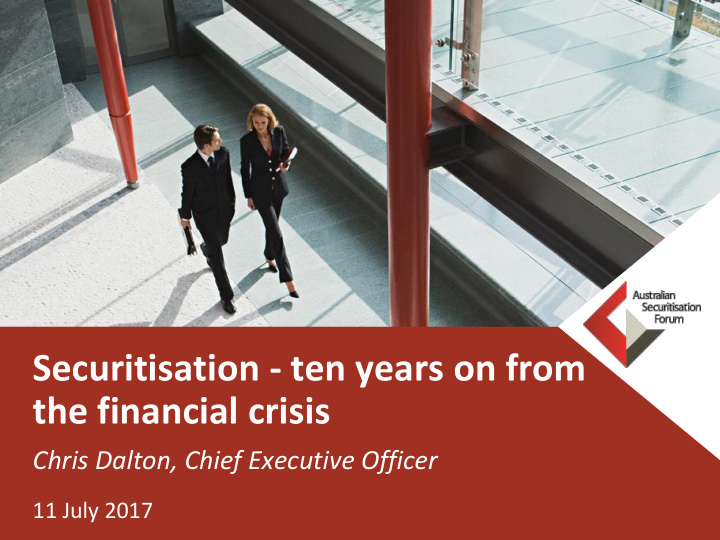



Securitisation - ten years on from the financial crisis Chris Dalton, Chief Executive Officer 11 July 2017
Today’s topics ▪ Current state of securitisation market ▪ Australia’s regulatory reform – New Securitisation Prudential Standard - APS 120 ▪ Capital relief securitisation ▪ Funding only securitisation ▪ Determination of regulatory capital – OTC derivatives reform 2
Funding by securitisation 3
RMBS by issuer type (2008 - 2017) 4
RMBS margins (2015 - 2017) 5
ABS issuance (2004 - 2017) 6
Underlying philosophy new APS 120 ▪ Covers an ADIs exposure as an issuer, investor or facility provider ▪ No implicit support from ADIs ▪ Separation of ADI and SPV ▪ Increased simplicity of structures ▪ No synthetic securitisation ▪ No simple, transparent and comparable (STC) framework ▪ APRA’s key focus is depositor protection and significant risk transfer is needed to reduce regulatory capital 7
Capital relief securitisations ▪ Focus is on transfer of significant credit risk to third parties: – ADI can retain no more than 20% of non-senior securities issued (in aggregate, and of any tranche); and – cannot hold or fund the acquisition of non-senior securities and provide other loss positions or credit enhancements which represent more than 20% of the loss cover for senior securitisation exposures at any time ▪ Must sell non-senior securities to third parties: credit risk mitigation techniques or other hedges do not count as sales ▪ Cannot repurchase non-senior securities once sold other than to effect a 10% clean up call ▪ No date-based calls for capital relief deals 8
Capital relief securitisations ▪ Funding must be in place for the life of the underlying pool ▪ ADI must model 10% clean up calls for liquidity purposes – measure, monitor and manage liquidity risk of call options ▪ Retained securities and other securitisation exposures (e.g. swaps) are risk weighted or deducted from CET1 capital (depending on rating) ▪ Cap on total capital requirement: no more than would have been held against assets had they not been securitised 9
Bank of Queensland Series 2017-1 REDS Trust 10
Funding-only securitisations ▪ New APS 120 explicitly acknowledges funding only transactions ▪ For regulatory capital purposes, securitised assets are treated as if the securitisation had never happened: – include securitised assets in calculating regulatory capital for credit risk (APS 112 or APS 113); – do not need to have regard to the interposed structure when assigning risk weights to securitised assets; – do not need to hold regulatory capital for facilities or exposures to the securitisation SPV where those relate to the securitised assets (e.g. interest rate swaps) ▪ All revolving credit facilities are funding-only 11
Funding-only securitisations ▪ Funding-only securitisations can include date-based calls – date-based call relates to senior securities only – non-senior securities must share pro rata loss allocation and have the same maturity – can’t change call date post -issuance – originating ADI must retain discretion to exercise call – cash flows must be able to meet any margin step-up – can’t structure call to avoid allocating losses ▪ Can include securities with bullet maturities – ‘hard bullet’ cannot be funded by originating ADI – ‘soft bullet’ can be funded by originating ADI 12
Funding-only master trusts ▪ A master trust allows multiple series of RMBS to be issued by an ADI that are backed by a common pool of assets ▪ Bullet maturity effected by a date – backed call (soft bullet) ▪ Seller holds pari passu senior notes along side investors ▪ Seller holds subordinated (loss absorbing) note ▪ APS 120 contemplates master trusts – Securitisation of revolving credit facilities – ‘Seller interest’ cannot be subordinated with respect to cash flows or losses to other senior securitisation exposures – Conditions for amortisation event (scheduled or early) 13
Self-securitisations ▪ Allows ADIs to create on-balance sheet collateral to post for cash under a repo agreement with the RBA ▪ Broadly, same set of requirements as other securitisations, but… – can undertake to RBA to repurchase securities – can repurchase / replace securitised assets to meet RBA eligibility criteria – self-securitisations are excluded from the rules prohibiting changes to underlying pool ▪ Treated as funding-only securitisation, and must comply with APS 120 from the time it is for repo with the RBA 14
Risk weighting hierarchy ▪ Two risk-weighting approaches – ratings-based approach (ERBA); or – supervisory formula approach (SFA) ▪ No internal assessment approach (IAA) 15
External Ratings-Based Approach Rating Current NEW APS 120 (2018) Senior Junior Senior Senior Junior Junior current current 1 year 5 year 1 year 5 year Long term AAA 7% 12% 15% 20% 15% 70% ratings AA+ 7% 12% 15% 30% 15% 90% Adjustment only for thickness AA 8% 15% 25% 40% 30% 120% shown AA- 8% 15% 30% 45% 40% 140% here Tier 1 Tier 1 A+ 10% 18% 40% 50% Deduction Deduction Tier 1 Tier 1 A 12% 20% 50% 65% Deduction Deduction Tier 1 Tier 1 A- 20% 35% 60% 70% Deduction Deduction Tier 1 Tier 1 BBB+ 35% 50% 75% 90% Deduction Deduction Tier 1 Tier 1 BBB 60% 75% 90% 105% Deduction Deduction Tier 1 Tier 1 BBB- 100% 100% 120% 140% Deduction Deduction
OTC derivative reform ▪ ASIC agreed to industry request to move away from two-sided report of non-centrally cleared securitisation swaps ▪ APRA agreed with industry to not impose margin requirements on non-centrally cleared securitisation swaps 17
For more information � PLEASE CONTACT: Chris Dalton Chief Executive Officer cdalton@securitisation.com.au www.securitisation.com.au 18
Recommend
More recommend